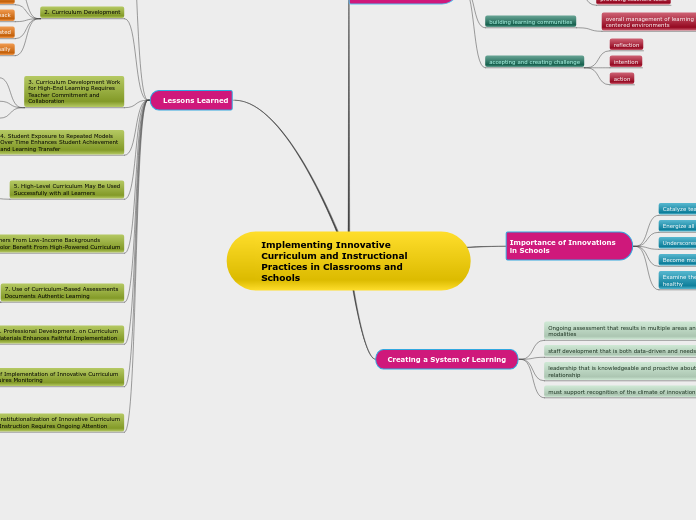Implementing Innovative Curriculum and Instructional Practices in Classrooms and Schools
Role of Leadership in Supporting Innovative Practices
multiple realities of working
human relation skills
task commitment skills
organizational structure
create meaning
integrity and helping people
attend overall growth
making teacher stronger
providing teachers tools
building learning communities
overall management of learning
centered environments
accepting and creating challenge
reflection
intention
action
Importance of Innovations
in Schools
Catalyze teachers and principals
Energize all staff in pro-active ways
Underscores effort, persistence and practice
Become more aware of educationla practices
Examine the adequacy of current practices in ways that are healthy
Creating a System of Learning
Ongoing assessment that results in multiple areas and modalities
staff development that is both data-driven and needs-based
leadership that is knowledgeable and proactive about the relationship
must support recognition of the climate of innovation
Lessons Learned
1: Curriculum Design
Learning goals and anticipated outcomes
Authentic assessments
content
concept
process
Higher-level thinking and reasoning
questioning
activities
Inquiry-based, meaningful, hands-on and minds-on experiences
graphic organizers
Accelerated reading and advanced resources
Broad-based concept
Metacognition and reflection components
2. Curriculum Development
Review of relevant research
Standards and curriculum
reform research
Pilot the entire unit
Revisions based on triangulation of the feedback
Units are field-tested
Units are revised and distributed nationally
3. Curriculum Development Work
for High-End Learning Requires
Teacher Commitment and
Collaboration
Discipline-specific expertise
Curriculum that will significantly enhance
student achievement
Careful instructional decision making
4. Student Exposure to Repeated Models
Over Time Enhances Student Achievement
and Learning Transfer
Teaching and Learning Models
Research-based, packaged curriculum
5. High-Level Curriculum May Be Used
Successfully with all Learners
Title 1 classrooms are good with nongifted learners
proper differentiation
Scaffolding
Flexible grouping techniques
6. Promising Learners From Low-Income Backgrounds
and Students of Color Benefit From High-Powered Curriculum
William and Mary units are effective
with special population of promising learners
Curriculum must be accompanied by faithful
use of teaching-learning models
7. Use of Curriculum-Based Assessments
Documents Authentic Learning
Essential component for measuring effectivess
of a curriculum
Measure aspects of content, concept and process learning
8. Professional Development. on Curriculum
Materials Enhances Faithful Implementation
Teacher is the key
Advanced intsructional practices
differentiation strategies
9. Fidelity of Implementation of Innovative Curriculum
Efforts Requires Monitoring
Curriculum needs to be monitored
Significant part
of the curriculum
Documentation matters
10. Institutionalization of Innovative Curriculum
and Instruction Requires Ongoing Attention
Long-Term sustainability
Guided and Intensive professional
development and monitoring
